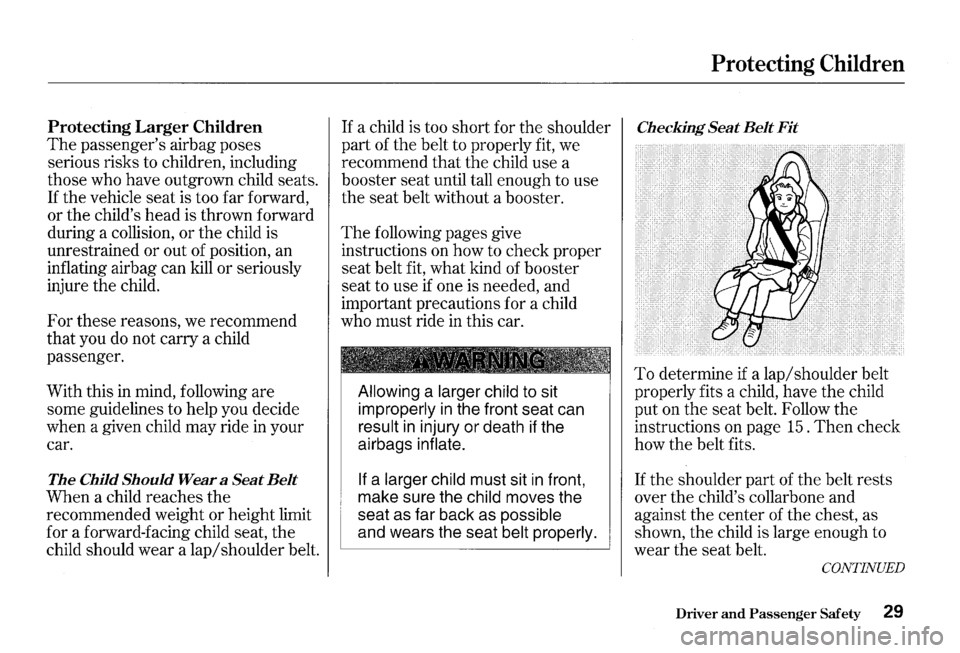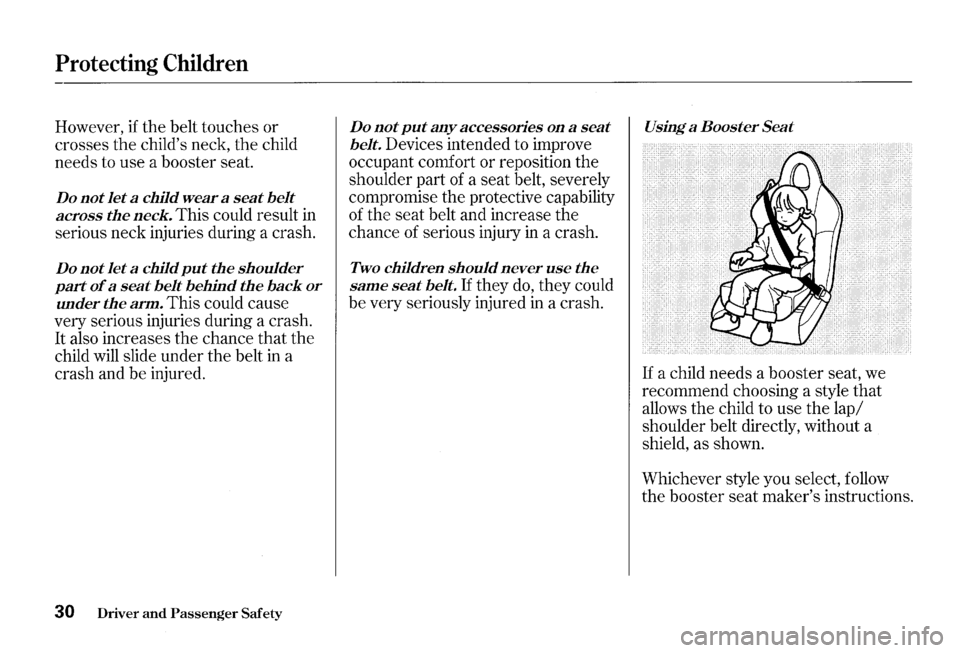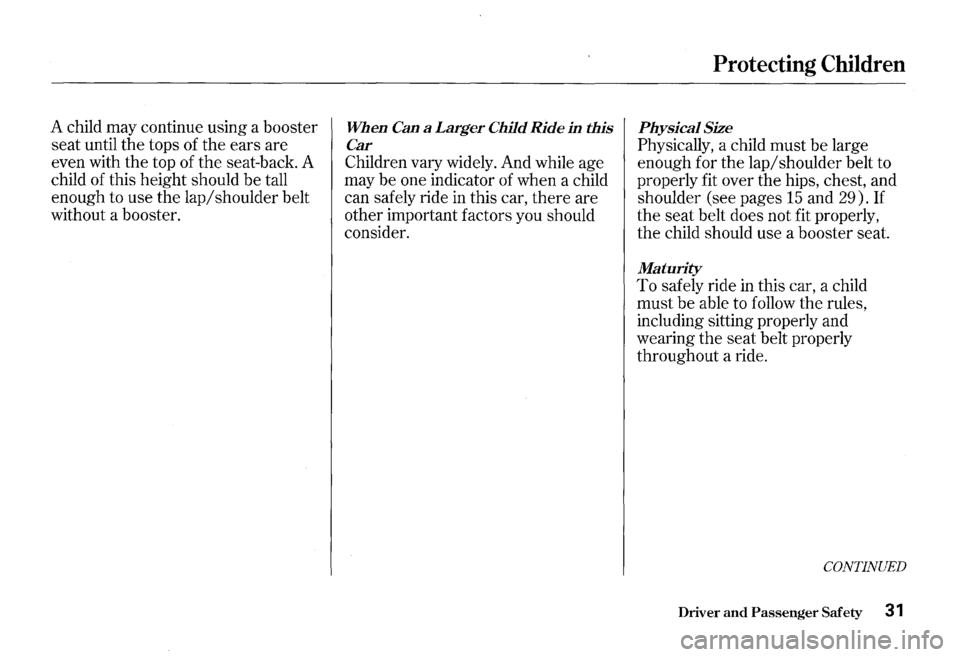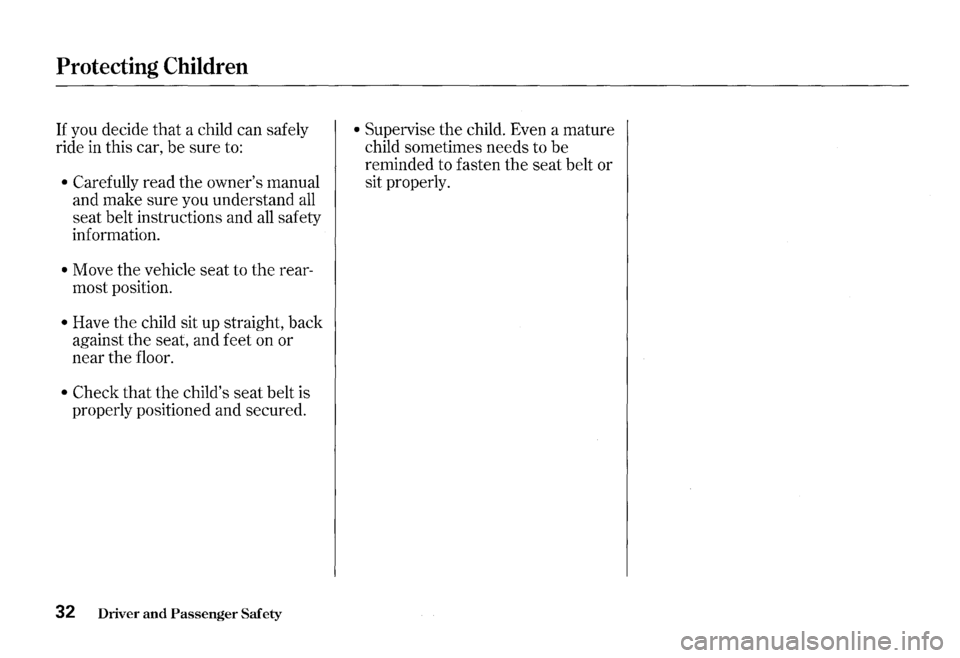2000 HONDA S2000 child seat
[x] Cancel search: child seatPage 32 of 273

Protecting Larger Children
The passenger's airbag poses
serious risks to children, including
those who have outgrown child seats.
If the vehicle seat is too far forward,
or the child's head is thrown forward
during a collision, or the child is
unrestrained or out of position, an
inflating airbag can kill or seriously
injure the child.
For these reasons, we recommend
that you
do not carry a child
passenger.
With this
in mind, following are
some guidelines to help you decide
when a given child may ride in your
car.
The Child Should Wear a Seat Belt
When a child reaches the
recommended weight or height limit
for a forward-facing child seat, the
child should wear a lap/shoulder belt.
If a child is too short for the shoulder
part of the belt to properly fit, we
recommend that the child use a
booster seat until tall enough to use
the seat belt without a booster.
The following pages give
instructions on how to check proper
seat belt fit, what kind of booster
seat to use
if one is needed, and
important precautions for a child
who must ride in this car.
Allowing a larger child to sit
improperly in the front seat can
result in injury or death if the
airbags
inflate.
If
a larger child must sit in front,
make sure the
child moves the
seat as far back as
possible
and wears the seat belt properly.
Protecting Children
Checking Seat Belt Fit
To determine if a lap/shoulder belt
properly fits a child, have the child
put on the seat belt. Follow the
instructions on page 15.
Then check
how the belt fits.
If the shoulder part of the belt rests
over the child's collarbone and
against the center of the chest, as
shown, the child is large enough to
wear the seat belt.
CONTINUED
Driver and Passenger Safety 29
Page 33 of 273

Protecting Children
However, if the belt touches or
crosses the child's neck,
the child
needs to use a booster seat.
Do not let a child wear a seat belt
across the neck. This could result in
serious neck injuries during a crash.
Do not let a child put the shoulder
part of a seat belt behind the back or
under the arm. This could cause
very serious injuries during a crash.
It also increases the chance that the
child will slide under the belt in a
crash and be injured.
30 Driver and Passenger Safety
Do not put any accessories on a seat
belt. Devices intended to improve
occupant comfort or reposition the
shoulder part of a seat belt, severely
compromise the protective capability
of the seat belt and increase the
chance of serious injury
in a crash.
Two children should never use the
same seat belt. If they do, they could
be very seriously injured
in a crash.
Using a Booster Seat
If a child needs a booster seat, we
recommend choosing a style that
allows the child to use the
lap/
shoulder belt directly, without a
shield, as shown.
Whichever style you select, follow
the booster seat maker's instructions.
Page 34 of 273

A child may continue using a booster
seat until the tops of the
ears are
even with the top of
the seat-back. A
child of this height should be tall
enough to use the
lap/ shoulder belt
without a booster.
JVhen Can a Larger Child Ride in this
Car
Children vary widely. And while age
may be one indicator of when a child
can safely ride in this car, there are
other important factors you should
consider.
Protecting Children
Physical Size
Physically, a child must be large
enough for the
lap/ shoulder belt to
properly fit over the hips, chest, and
shoulder (see pages
15 and 29). If
the seat belt does not fit properly,
the child should use a booster seat.
Maturity
To safely ride in this car, a child
must be able to follow the rules,
including sitting properly and
wearing
the seat belt properly
throughout a ride.
CONTINUElJ
Driver and Passenger Safety 31
Page 35 of 273

Protecting Children
If you decide that a child can safely
ride in this car, be sure to:
• Carefully read the owner's manual
and make sure you understand
all
seat belt instructions and all safety
information.
• Move the vehicle seat to the rear
most position.
• Have the child sit up straight, back
against the seat, and feet on or
near the floor.
• Check that the child's seat belt is
properly positioned and secured.
32 Driver and Passenger Safety
• Supervise the child. Even a mature
child sometimes needs to be
reminded to fasten the seat belt or
sit properly.
Page 36 of 273

Seat Belt System Components
Your seat belt system includes lap/
shoulder belts in both seating
positions.
The seat belts are also equipped with
automatic seat belt tensioners.
~ The system also includes a
l±J light on the instrument
panel to remind you and your
passenger to fasten your belts.
If the
driver's seat belt is not fastened
before the ignition is turned
ON (II),
the light will come on and a beeper
will also sound.
The beeper will stop
after a few seconds,
but the light will
stay on until the driver's seat belt is
fastened.
Additional Information About Your Seat Belts
Lap/Shoulder Belt
This seat belt has a single belt that
goes over your shoulder, across your
chest and across your hips.
To fasten the belt, insert the latch
plate into the buckle, then tug on the
belt to make sure the buckle is
latched.
To unlock the belt, push the red
PRESS button on the buckle. Guide
the belt across your body to the door
pillar. After exiting the car, be sure
the belt is out of
the way and will not
get closed in the door.
Both seat belts have an emergency
locking retractor.
In normal driving,
the retractor lets
you move freely
in your seat while it
keeps some tension on the belt.
During a collision or sudden stop,
the retractor automatically locks the
belt to help restrain your body.
The passenger's seat belt has an
additional locking mechanism that
must be activated to secure a child
seat. (See page
27 for instructions on
how to secure a forward-facing child
seat with this type of belt.)
If the shoulder part of the belt is
pulled
all the way out, the locking
mechanism will activate.
The belt
will retract, but it will not allow the
passenger to move freely.
CONTINUED
Driver and Passenger Safety 33
Page 43 of 273

Safety Labels
These labels are in the locations
shown.
They warn you of potential
hazards that could cause serious
injury. Read these labels carefully.
If a label comes off or becomes hard
to read, contact your Honda dealer
for a replacement.
DASHBOARD U.S. models only
A WARNING
Children Can Be KILLED or INJURED by Passenger Air Bag Male sure all ctilcran use aeatbalts or~ild seata
40 Driver and Passenger Safety
SUN VISOR
U.S. models
Canadian models
SEAT BELT TENSIONER
I ... "·'·"''""" I ... ~iEUl1>11 I UrLOIIH "'•[OIH '""'"' ~"'"'""'lOS I' o l'oN""""" ..... , ..... , ... , ......... , .. _ , .... , ............. , ........... . •Do ,., "~'" " ""'"~'" ""' "" .,.,,. •• ''"""" '"" '" ··-...... ~ .. """ •h••'"-"' "~"'" ~;··;;;;;;;;:·:7 .. ·.:~··· :~;::;~::;;;;;::;:::::·;:::~:~::~:~~···
BATTERY
SUPPLEMENTAL RESTRAINT SYSTEM (SRS)@ ~~~'-------=::_'7=~i-Y~~----I This vehlclf Is equipped with driver and front seal passenger airbags All S RS electrical wir1ng and con 1ecto rs ore co I or ed ~ell ow. Tamoering wit~, disconnecting or using e I ec ~~ i ca I test equIpment on the S R S wl rln g can maXe the syslem inoperatiH or cause Hcidentat firing of th inflator A WARNING The alrbag Inflator Is uplosive and, II a c c ide r.t a II y de p I o ~ e d, can serious I y h urI 'IOU Fc',lcw Service Manual instructions caretulll'·
Page 269 of 273

Index
Opening the Hood ......................... 118 Protecting Small Children .......... 26 Replacing Seat Belts After a
Opening the Trunk .......................... 66 Crash ............................................. 34
Operation in Foreign Countries
... 249 R Restraint, Child ................................ 19
Outside Mirrors ............................... 79 Rotation, Tire ................................. 188
Overheating, Engine ..................... 223 Radiator Overheating .................... 223
Oxygenated Fuels .......................... 248 Radio Sound System ........................ 94 s
Rear End Towing ........................... 238 p Rear Lights, Bulb Replacement ... 198 Safety Belts ......................................... 8
Rear
View Mirror ............................. 79 Safety Defects, Reporting ............. 258
Paint Touch-up ............................... 206 Reclining the Seat-backs ................. 68 Safety Labels, Location of .............. 40
Panel Brightness Control ............... 52 Recommended Shift Speeds ........ 134 Safety Messages ................................ ii
Parking Brake .................................. 80 Recovery Vehicle, Emergency Seat Belt, Additional Information .. 33
Parking Lights .................................. 51 Towing ........................................ 238 Lap/Shoulder Belt ....................... 33
PGM-FI System .............................. 251 Reminder Lights .............................. 43 Seat Belt Maintenance ................ 34
Polishing and Waxing ...................
205 Remote Transmitter ........................ 63 Seat Belt System Components ... 33
Power Replacement Information Seat Belts ............................................ 8
Door Locks ...................................
62 Air Cleaner ................................. 172 Cleaning ...................................... 207
Engine, Specifications ............... 244 Engine
Coolant.. ......................... 163 Maintenance ................................. 34
Mirrors .......................................... 79 Engine Oil and Filter ................. 159 Reminder Light and Beeper ....... 44
Windows ....................................... 69 Fuses ........................................... 232 System Components .................... 33
Pregnancy, Using Seat Belts .......... 17 Light Bulbs ................................. 194 Use During Pregnancy ................ 17
Protecting Adults ............................. 12 Schedule ..................................... 146 Seats, Adjusting the ......................... 68
Additional Safety Precautions .... 18 Spark Plugs ................................. 17 4
Serial Number ................................ 242
Advice for Pregnant Women ...... 17 Tires ............................................ 189 Service Intervals ............................ 146
Protecting Children .........................
19 Wiper Blades .............................. 180 Service Manual .............................. 259
Protecting Larger Children ........
29 Service Station Procedures .......... 117
VI